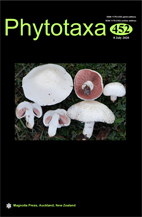Abstract
Myrcia adulterina, a new species from the Brazilian Atlantic Forest, is here described, illustrated and compared with morphologically related species. Additionally, its distribution map and a preliminary conservation status are presented. The new species is here inferred as belonging to Myrcia sect. Reticulosae due its leaves with raised venation, staminal ring densely pilose, hypanthium prolonged in a tube with glabrous inner walls and 3-locular ovaries. Within this section, the species is morphologically related to Myrcia pubipetala, from which it can be distinguished through the laxly reticulate leaf venation and thyrsoid inflorescences with all axes strongly flattened and striated when dry. Myrcia adulterina was misidentified during at least 15 years in herbaria under the name Marlierea tomentosa (currently synonym of Myrcia strigipes, a species belonging to Myrcia sect. Aulomyrcia), which is also morphologically similar. A brief discussion clarifying the morphological differences between these species is also presented.

